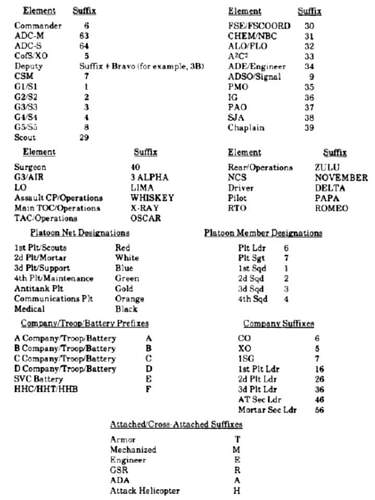There are a number of YouTube videos that have recorded tactical radio chatter from the Vietnam War. There are also a number of free or inexpensive programs that can be used to download and convert the video sound into MP3 (or other audio files).
The phonetic alphabet that would have been in use can be found on Wikipedia (along with the WWII version for anyone interested in that).
Radio callsigns would have been constantly changing on a daily basis for most units according the Signal Operating Instructions (SOI) / Communications-Electronics Operations Instructions (CEOI) in effect at any given time.
You can find an SOI/CEOI sample here:
SOI/CEOI Sample Pages
In use, most callsigns were abbreviated so that only the last letter was used along with the expander digits. Although the callsigns in this sample are “modern,” a Vietnam War SOI would have looked essentially identical (just with different ramdomized, letter-digit-letter callsigns. The entire purpose is to not have any sort of predictable pattern.
Once abbreviated callsigns are in use (“abbreviated callsigns in-effect” in the US Army parlance as the net-control station accepts and instructs a new outstation into the radio network, aka the “net”) an expander (aka a “suffix”) is added to identify the user’s position within the outstation’s unit. These expanders are generally durable and don’t change often. An example is the expander “six” (6) used to identify the unit commander as he’s talking over the radio. “This is ‘Charlie-Six’” could be an example of an abbreviated callsign using the letter “C” (Charlie) with the expander “six” (6) to identify that the speaker is the actual unit commander.
Here’s an example of expanders or suffixs that could be used on the end of any particular radio call sign to indicate the speaker’s position and function within the call sign’s unit:
(I stuck this in since it took a bit of interweb digging to find it. I knew what I was looking for, but it might have been a bit more difficult for someone else to spot.)
Additionally, there are “prowords” that are commonly used to shorten and clarify messages. A quick Google search of the term “radio proword” will turn up lists of the ones used in the US military. These have not changed much since WWII and hardly at all since Vietnam.
I don’t know what exactly your friend is planning, but I’m in the process right now of restoring a WWII SCR-610 radio set. I’ve installed a small MP3 player in it with recorded WWII tactical radio chatter mixed with a couple of period “moral” songs. No need to go into details here, but when one of the operating knobs on the front is turned, the MP3 player switches on and the recorded tactical chatter and music plays out of the radio speaker (along with animating the signal strength meter on the front panel). Makes for an interesting display in my collection.
